Nabak Kimchi is a mild and refreshing water Kimchi that’s made with very few ingredients that’s traditionally enjoyed in the spring. This clean and clearing kimchi is a great welcome after a long freezing winter in Korea. Vegan and Gluten Free. No fish sauce.
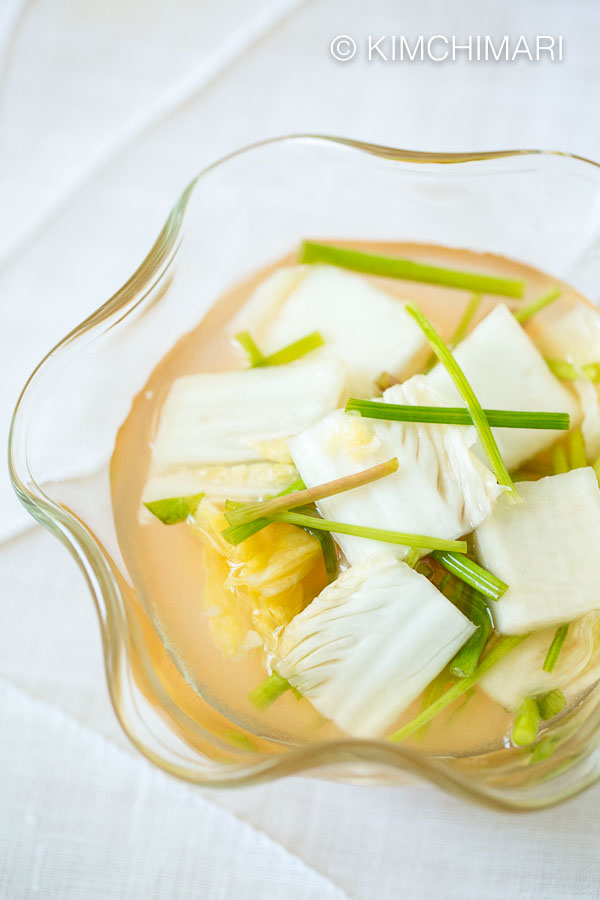
Nabak Kimchi or Nabak Mul Kimchi is a kimchi that you may have most often seen served as the very 1st course or with some Juk (try with my Hobak juk) at fancy Korean restaurants where they serve Korean food in courses instead of all at once. As you may know, Korean food is traditionally served all together, in one table setting. But in modern times, high-end restaurants decided to follow the western style and break up the meal to serve in courses.
So.. even though it was just meant to be served with a meal, Koreans found that this kimchi serves as a great appetizer and a meal starter. You get a few spoonfuls of this kimchi and it totally wakes up your tastebuds and your appetite.
Whenever I think of the best version I ever had, I think about my mother-in-law’s Nabak Kimchi. My mom made this kimchi too but for some reason not much anymore.. But whenever I visit my mother-in-law in Korea in the spring or in warmer months, she ALWAYS makes this Nabak Mul kimchi for us.
And recently, when we visited Seoul to attend my father-in-law’s 100th day of passing ceremony, she made this wonderfully simple spring Kimchi with just 6 ingredients for the family gathering. So this time, I got to finally watch her make it!! I took videos so I will share that on my Instagram story as soon as I publish this post. So this recipe idea is from her but of course, I had to turn it into a recipe with some modifications as she had no measurements..🙃
What is Nabak Kimchi (나박김치)?
Also called Nabak Mul Kimchi (나박물김치). Now, Nabak Sseolki 나박 썰기 in Korean refers to a cut that is most similar to Paysanne cut in French cooking. The resulting cut is a square or rectangle cut (see pic below) that is thin but not too thin. So the most common theory is that the name comes from the fact that the cabbage and radish are always cut into Nabak cuts for this kimchi.

Nabak Kimchi is a mild water kimchi made with radish, cabbage, minari (mugwort) and sometimes fruits like pear or apple. The kimchi is supposed to be eaten within a short time because it’s just not good once it over ripens and really sours – unlike the traditional Baechu Kimchi which can be kept for many months to ever years.
Nabak Kimchi vs Mul Kimchi vs Dongchimi – What’s the difference?
In short, Nabak Kimchi is a special kind of Mul Kimchi (물김치 water kimchi) which are enjoyed during spring and summer. Dongchimi (동치미) on the other hand is also a water kimchi with lots of liquid but it is meant to last through the winter – hence the name Dongchim which comes from the word 동침(冬沈) – Dong meaning ‘winter’.
Different kinds of Mul Kimchi – (I will not repeat ‘mul kimchi’ after each name but assume it all goes like the first one..)
- Yeolmu Mul Kimchi (열무물김치 with young radish)
- Gochu (고추 green chili pepper)
- Minari ( 미나리 water dropwort)
- Sangchu (상추 lettuce)
- Sigeumchi (시금치 spinach)
- Juksun (죽순 bamboo shoots)
- Oyi (오이 cucumber)
Other differences –
- Nabak Kimchi and most Mul Kimchi are often made in varying degrees of spice level by adding more or less fine gochukaru (red chili powder) but please don’t make it red!!
- Dongchimi NEVER has gochukaru added. It’s always white and big chunks of radish is used
- Nabak Kimchi and other Mul Kimchis are meant to be consumed in a few weeks whereas Dongchimi is supposed to last through the winter months and beyond
Chef’s Tips for Best Nabak Kimchi
- Use good quality fresh Korean radish (mu) for best results. They should be really hard when you press it and the skin should not feel rubbery or wrinkly. Choose ones that are heavier relative to size. If the radish has tiny air holes inside when you cut it, it’s not going to taste good.
- Buy a big cabbage that’s OVER 1 kg because you will not be using the outer green leaves but only the inner leaves that are yellow. Set aside the outer green leaves to make Baechu Doenjang Guk.
- Substitute green onions for Minari (if you can’t find it) or add them in addition. But try to find Minari because it really does add a great flavor to it.
- For extra zing, try adding a splash of sprite right before serving.
- Use a paper tea bag to color the water with red chili powder. Traditionally a fine linen or mesh bag was used. You can also use a really fine sieve to swirling the gochukaru in the liquid within the sieve. The main thing is you don’t want little specks of chili powder floating around because that will muddy the liquid and also take away the clean and clearing flavor of the kimchi water.
- Add some sugar (1/2 of salt amount) when pickling radish and cabbage (if you want) for sweeter tasting kimchi. I like the clean, not sweet taste better myself so I don’t add. Sometimes I add maesil syrup at serving time, mainly for guests.
Step-by-Step Directions
Vegetable Ingredients (Minari is optional)

DAY 1
- RADISH:
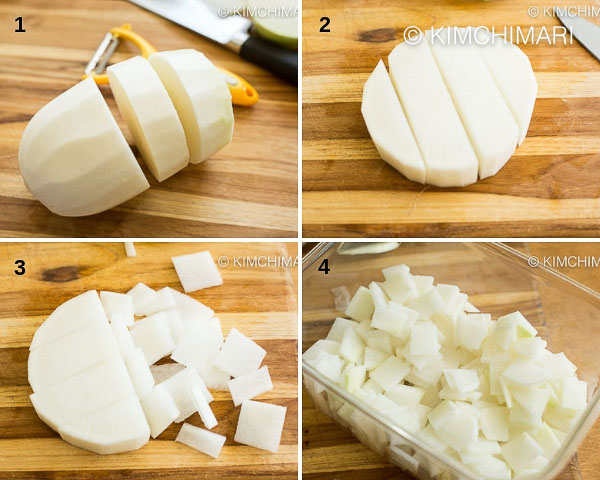
Steps for cutting radish for Korean Nabak Kimchi - Peel radish and cut into discs about 1 inch thick.
- Cut each disc into 4 equal baton shapes first and then slice across to make Nabak (Paysanne) cuts
- Add cut radish into kimchi container.
- Sprinkle 1/2 of salt on top of the radish and toss with hands to evenly coat radish with salt.
- CABBAGE:
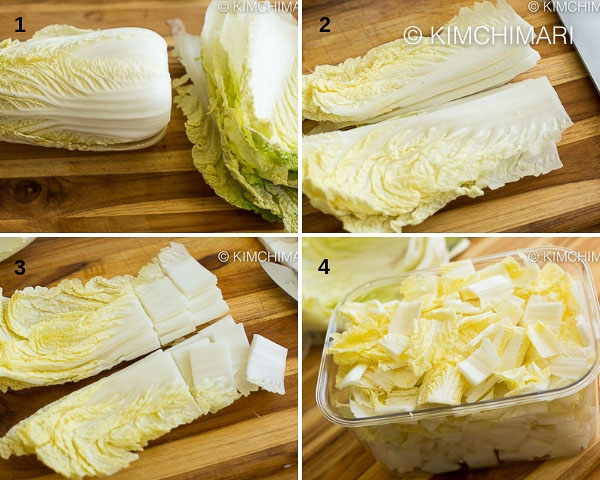
how to cut Napa Cabbage for Nabak Kimchi - Cut off the root end or head of the napa cabbage to take off the outer leaves of the napa cabbage. Do this until you only see the yellow leaves and no green leaves. Cabbage with the green leaves removed should be close to 1 kg (more or less).
- Keep cutting the head of cabbage to loosen all the leaves. Gather leaves of similar size, stack them up and cut it lengthwise and then across to make Nabak (Paysanne) cuts.
- Add cut cabbages on top of the cut radish in the kimchi container and sprinkle remaining salt on top of the cabbage. Toss with your hands again.
- Leave the radish and cabbage salted for 30 minutes to 1 hour while you work on the seasoning.
- Finish Kimchi
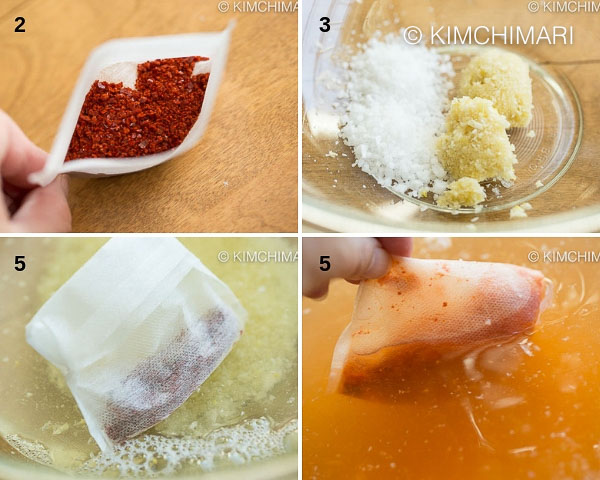
Making kimchi liquid for Nabak Water Kimchi - Preheat oven to 100°F (37.7°C) or use a PROOF function if you have it. Yes, we are turning the oven on!! 😜
- Fill a tea bag with red chili powder (gochukaru). Use more chili powder for more kick but do NOT add so much that the liquid becomes totally red. Nabak kimchi is supposed to have light pink color not red.
- In a glass or metal bowl (big enough to hold all the kimchi liquid), add chopped garlic and salt. Optionally add sugar – (about 1/2 amount of salt). *Adding sugar definitely will taste better but it can sometimes make the kimchi not as clean tasting and also will sour more quickly.
- In another bowl, make 6.5 cups very warm water that’s about 110℉/43℃. Heat water to temp or make this by mixing about 4 cups room temp water and 2.5 cups of HOT boiling water. (This is hotter than very warm bath water but not soo hot that you will burn your hands nor cook the vegetables. When you dip your hands in it, you should feel like it’s OMG IT’S HOT but it actually won’t burn your hands.) * Please be careful to NOT burn your hands.
- Quickly add the VERY WARM water to the bowl with garlic and salt. Also add the red chili powder packet from 1. Stir quickly until salt is all dissolved. We want to do this step as quickly as possible so the water doesn’t cool down too much but it’s OK if it cools down a bit.
- SPEED RIPEN KIMCHI
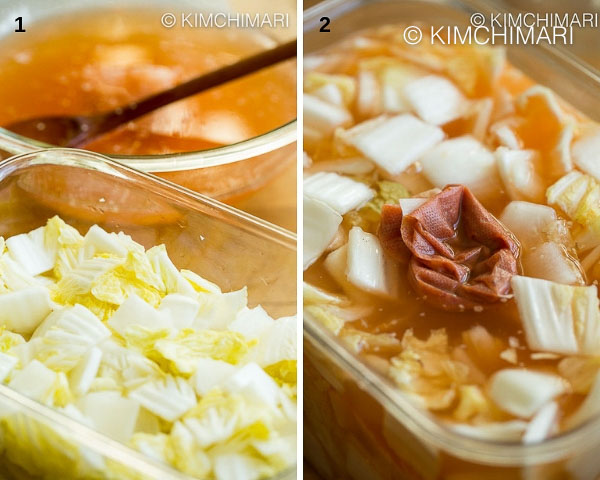
Making and Adding Nabak Kimchi liquid - Pour KIMCHI LIQUID from 3 in the container with salted radish and cabbage.
- Cover the container and put in the oven. Turn the heat off and just leave the oven light on. The heat from the light should be enough to keep things warm. I checked it next morning and it was still warm to the touch and this is good enough.
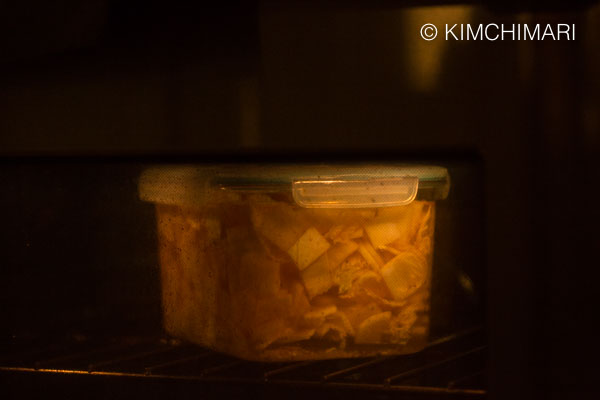
Nabak Kimchi in fermenting in Oven Check after about an hour and feel the temperature of the kimchi container. It should still feel nice and warm. If not, you can take out some of the water, reheat it and put it back in.
- After 24 hours, it should taste quite fully ripe, a little bit tangy or sour. This is a great tip I learned from my mother-in-law. This way of quickly ripening the water kimchi adds an extra zing to it.
DAY 2 (after 24 hrs)
- Take Nabak Kimchi out of the oven.
- Rinse Minari (water dropwort) and drain.
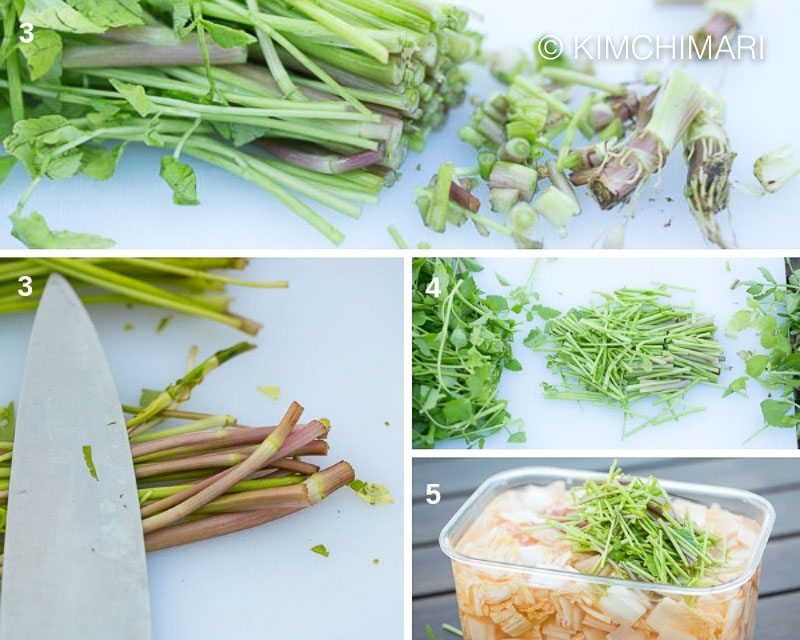
How to cut minari for kimchi - Cut root ends along with the parts that are thick, usually also darker in color.
- Cut Minari stalk into 1.5 inch long pieces, avoiding the leafy parts. The leafy parts will be good in the kimchi after it ripens so avoid it.
- Stir in Minari into the kimchi.

Nabak Kimchi – Spring Water Kimchi (vegan and gf) - Remove the bag of chili powder from the liquid.
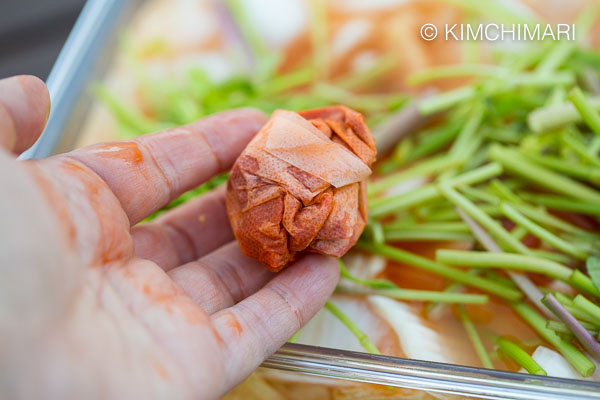
Squeeze out and remove red chili tea bag from kimchi - OPTIONALLY – add some cut green onion (about 1 bunch) if you’d like.
- Put back finished Nabak kimchi in the fridge or your kimchi refrigerator. Let it ripen for 2-3 more days. And there you have it!!
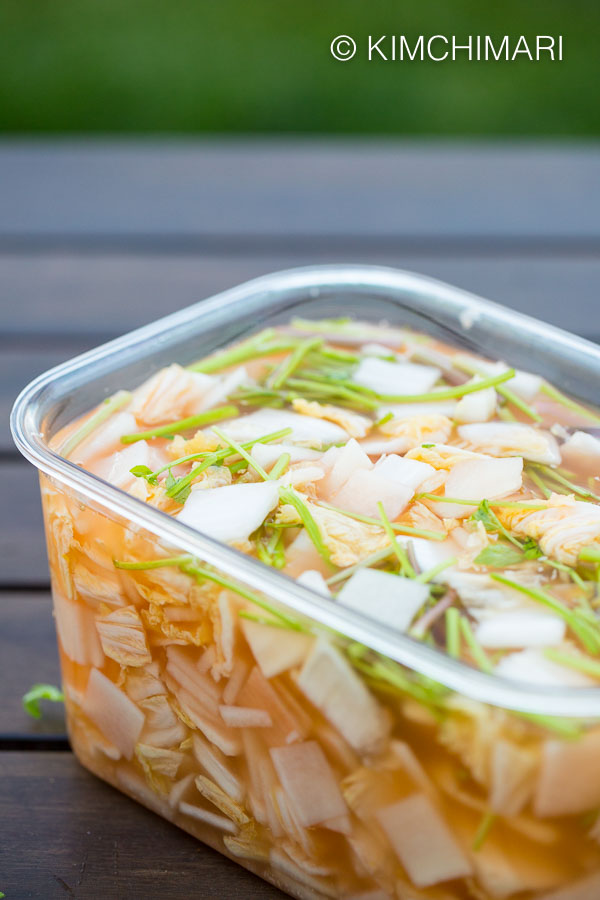
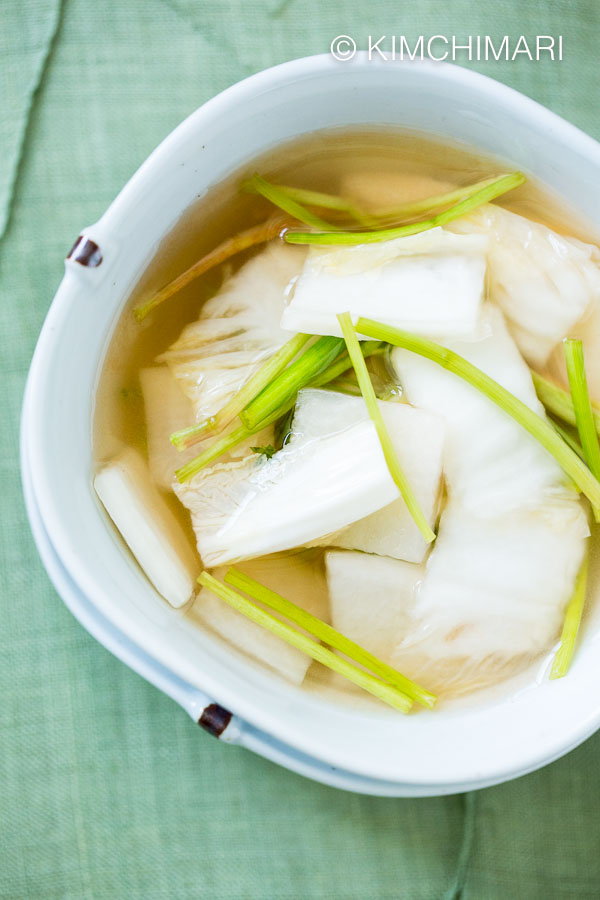
SERVING SUGGESTIONS
- Always SERVE COLD right from the fridge.
- If you want to add a little bit of sweet flavor (which some people prefer), you can add a swirl of maesil syrup or a splash of sprite.
- For a touch of color, add some Shilgochu (실고추) which are thin threads of dried red chili pepper.
 Nabak Kimchi closeup
Nabak Kimchi closeup - This is a great first-time kimchi for kids. Make it even less spicy and you can get easily get your kids started on kimchi this way.
- Traditionally served with Juk like Hobak or Heukimja juk. Great with any Korean BBQ or with any dishes that are very spicy or heavily seasoned. This Kimchi will add a lovely touch of freshness to your meal.
Try more Kimchi Recipes~

If you have tried this Nabak Kimchi or any other recipe on my blog then please don’t forget to rate the recipe (top right of the recipe card) and leave me a comment to let me know how you like it! Every 5 star helps me a lot and I also love to hear from you! 😍
You can also FOLLOW ME on FACEBOOK, PINTEREST and INSTAGRAM or join my FACEBOOK GROUP to see other Korean recipes to ask and share everything about Korean food with others just like you!
HAPPY SPRING!! 🌿🌸
XOXO ❤️
JinJoo
Nabak Kimchi - Spring Water Kimchi with Cabbage and Radish
Ingredients
Pickling radish and cabbage
- 2.2 lb Korean Radish (sub Daikon OK) (2.2 lb = approx. 1 kg)
- 2.2 lb Korean Kimchi Cabbage (or Napa Cabbage)
- 2 Tbsp Korean sea salt (Cheonilyeom) (for pickling)
Kimchi liquid
- 2 Tbsp Korean sea salt (Cheonilyeom)
- 2 Tbsp garlic (chopped)
- 1 Tbsp Korean red chili powder (gochukaru) (more to taste)
- 6.5 cups very warm water (110℉)
Optionally add 1~2 Tbs sugar for sweeter version
Minar (Water Dropwort) - optional, if you can't find it, just add a little bit of green onion
- 1.5 cups minari (water dropwort) (cut into 1.5 inch lengths)
Instructions
Prepare RADISH
- Peel radish and cut into discs about 1 inch thick.
- Cut each disc into 4 equal baton shapes first and then slice across to make Nabak (Paysanne) cuts. Add cut radish into kimchi container.
- Sprinkle 1/2 of salt on top of the radish and toss with hands to evenly mix in the salt.
Prepare CABBAGE
- Cut off root end of the napa cabbage to take off all the outer green leaves. Set aside the outer green leaves for regular kimchi or to make Baechu Doenjang Guk.
- Cut off the root end again to loosen more leaves. Gather leaves of similar size, stack them up and cut it lengthwise and then across to make Nabak (Paysanne) cuts.
- Add cut cabbages on top of the cut radish and sprinkle remaining salt. Toss with your hands again. Set aside while you work on the seasoning.
TURN ON OVEN to 100 ℉ (37.7°C) or my oven has a PROOF function which is the same thing.
Make KIMCHI LIQUID
- Fill a tea bag with red chili powder (gochukaru). Increase amount for more kick but do NOT add so much that the liquid becomes red. Nabak kimchi is supposed to have light pink color not red.
- In a glass or metal bowl big enough to hold all the kimchi liquid, add chopped garlic and salt. Optionally add sugar - (1/2 amount of salt). *Adding sugar definitely will taste better but it doesn't make the kimchi as clean tasting and also it will sour more quickly.
- In another bowl, make 6.5 cups very warm water that's about 110℉/43℃. Heat water to temp or make this by mixing about 4 cups room temp water and 2.5 cups of HOT boiling water. (This is hotter than very warm bath water but not soo hot that you will burn your hands nor cook the vegetables. When you dip your hands in it, you should feel like it's TOO HOT but it actually won't burn your hands. * Please be careful to NOT burn your hands.
- Quickly add the VERY WARM water to the bowl with garlic and salt. Stir quickly until salt is all dissolved. We want to do this step as quickly as possible so the water doesn't cool down too much.
- Pour the warm salt water from above onto the kimchi container with the pickled radish and cabbages. Cover the container and put it in the oven for 24 hours. Check after about an hour and feel the temperature of the kimchi container. It should still feel nice and warm. *** This way of quickly ripening the water kimchi adds an extra zing to it.
NEXT DAY (approx after 24 hrs)
Prepare MINARI (Water Dropwort)
- Rinse Minari (water dropwort) and drain.
- Cut root ends - the thick, usually darker colored part. Then cut Minari stalk into 1.5 inch long pieces, avoiding the leafy parts.
- Take kimchi out from the oven. Uncover and first take out the bag of chili powder that has been soaking.
- Add cut minari and mix it evenly into the kimchi with a spoon.
- Cover and put finished kimchi in the fridge. Or in your kimchi refrigerator if you have one and let it ripen for 2-3 more days.
SERVE!
- Taste the kimchi. It should taste very clean and slightly sour with an awesome zing when it's perfectly ripe. If you want to add a little bit of sweet flavor, you can add a swirl of maesil syrup or a splash of sprite.
Tips & Notes:
- If you want to add a little bit of sweet flavor (which some people prefer), you can add a swirl of maesil syrup or a splash of sprite.
- For a touch of color, add some Shilgochu (실고추) which are thin threads of dried red chili pepper

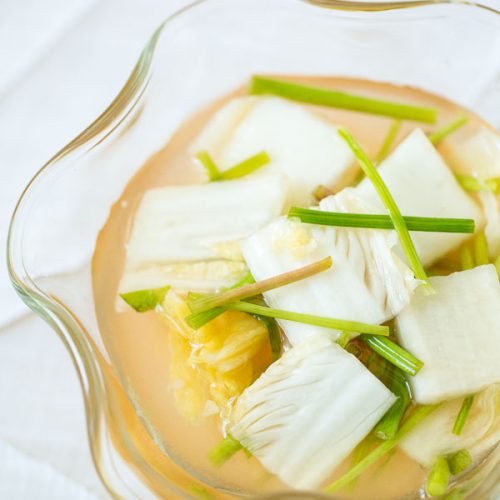
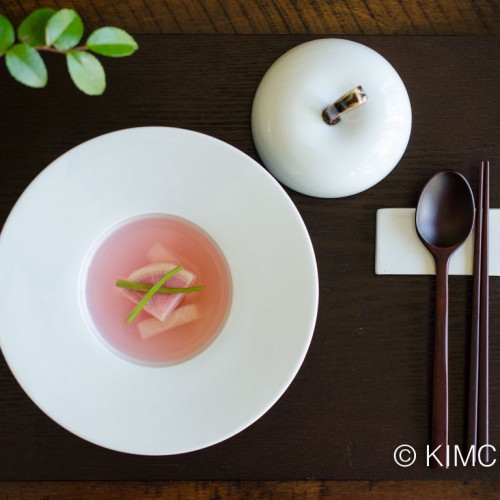
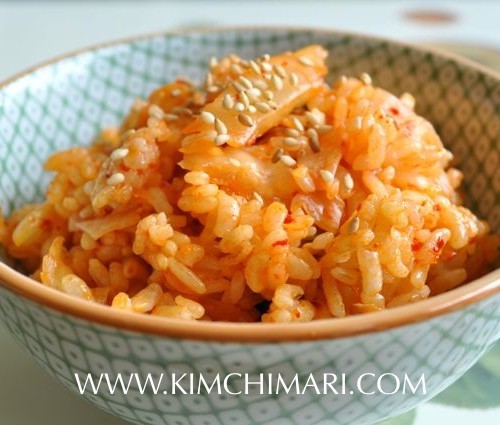

















Hi May I know how long will the Nabak Kimchi last in the fridge? Can it last for 1 to 2 months?
Nabak kimchi won’t last very long.. probably 1 month would be the max. Once it sours, there really isn’t much you can do with it and is not really pleasant to eat.
I usually guesstimate my measurements but sometimes it’s nice to have a form of reference. Followed yours and it came out perfect!
Easy yummy recipe!
Made this recipe. Just found out how to rate your recipe. I made it without sugar and had some added some ginger ale and some plain. Love them both
This sounds delicious! What do you do to ripen it if your oven won’t go down to 100 degrees? Mine won’t go below 170, which seems much too hot.
Do you have an electric blanket? You can turn on the blanket to highest setting, put a layer of towel then put the container and cover it up. See my IG story video to see how my mother-in-law did it. If you don’t have an electric blanket, you can just let it ripen at room temperature – it’s just not probably going to have as much zing as if you speed ripen it but it could also turn out OK. Thank you and good luck!
How long does it keep for? And what recipes can I use leftovers for?
It can keep for couple weeks but not too long. You can use it to make cold broth for cold kimchi noodle soup or Naengmyeon and maybe a quick Kimchimari rice with some of it but other than that there isn’t much else.